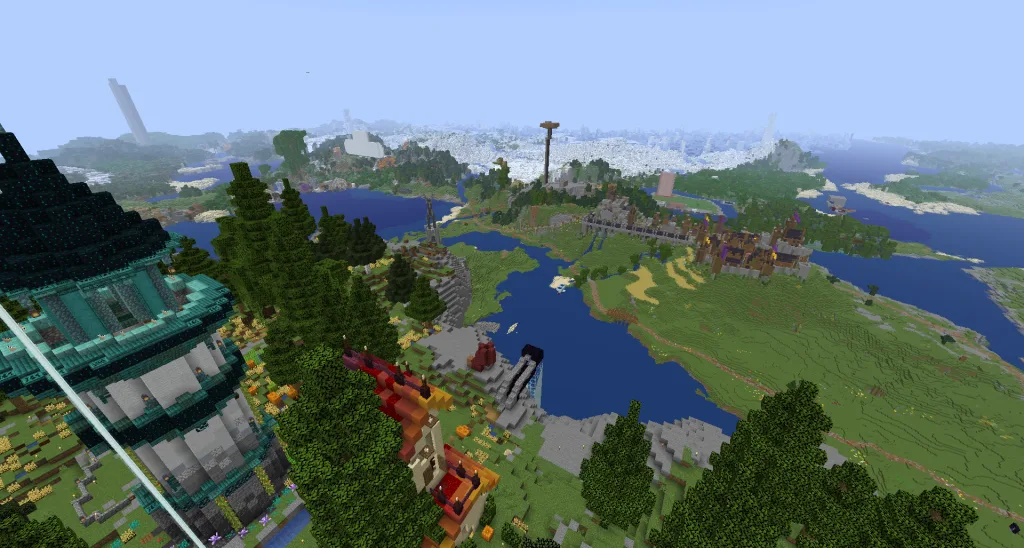When it comes to Minecraft modding, few modifications demand as much respect for your hardware as the Distant Horizons mod. While most players focus on RAM allocation and GPU power, this revolutionary rendering mod tells a different story—one where your CPU becomes the star of the show. Understanding why can make the difference between stunning infinite vistas and frustrating frame drops.
Table of Contents
Minecraft CPU-Intensive Reality of Distant Horizons
Unlike traditional Minecraft performance mods that primarily stress your graphics card, Distant Horizons is fundamentally different. The mod can utilize up to 90% of available CPU load while generating ultra-long draw distances with its LOD (Level of Detail) system. This isn’t a bug—it’s the price of revolutionary terrain rendering that extends your view distance far beyond Minecraft’s default limitations.

System Requirements Breakdown
| Component | Minimum Spec | Recommended | Enthusiast | Why It Matters |
|---|---|---|---|---|
| CPU | Ryzen 5 3600 / i5-10400 | Ryzen 5 5600X / i5-12400 | Ryzen 7 5800X3D / i7-12700K | Chunk generation and LOD processing |
| RAM | 16GB (8GB allocated) | 32GB (12-16GB allocated) | 32GB+ (20GB allocated) | Terrain data caching |
| GPU | GTX 1660 / RX 570 | RTX 3060 / RX 6600 XT | RTX 4070+ / RX 7800 XT | Shader compatibility |
| Storage | SSD (any type) | NVMe SSD | High-speed NVMe | Chunk loading speed |
The Multi-Core Advantage: Why Modern CPUs Excel
Most modern multi-core CPUs, like Ryzen 5 and its Intel equivalent, can handle the load of the render mod effectively when they prioritize strong single-core and multi-thread performance. This dual requirement makes CPU selection crucial—you need both raw single-thread speed for Minecraft’s main thread and multiple cores for Distant Horizons’ parallel processing.
CPU Performance Hierarchy for Distant Horizons:
- AMD Ryzen 7 5800X3D – The 3D V-Cache provides exceptional performance for chunk generation
- Intel Core i7-12700K – Strong hybrid architecture balances single and multi-thread performance
- AMD Ryzen 5 5600X – Best price-to-performance ratio for most users
- Intel Core i5-12400 – Budget-friendly option that still delivers solid results
The Storage Secret: Why Your SSD Matters
Storage plays a major role in chunk loading and LOD generation, with SSDs providing improved read/write speeds that result in faster terrain and chunk generation. This often-overlooked component can be the difference between smooth exploration and stuttering world loading.
SSD Impact on Performance:
- HDD: 2-5 minute initial chunk generation
- SATA SSD: 30-60 second initial load times
- NVMe Gen 3: 15-30 second startup
- NVMe Gen 4: Sub-15 second world loading
Discover more Minecraft optimization guides and performance tips at TechnoSports for comprehensive gaming coverage.

RAM Allocation: The Shader Consideration
For vanilla aesthetics, 6-12GB allocation suffices, but shader users should allocate 16-20GB on systems with 32GB total RAM. This dramatic difference highlights how visual mods compound the resource requirements of Distant Horizons.
Memory Allocation Guidelines:
- Vanilla + Distant Horizons: 6-8GB allocated RAM
- With Basic Shaders: 10-12GB allocated RAM
- With Intensive Shaders: 16-20GB allocated RAM
- Extreme Modpack: 20-24GB allocated RAM (requires 32GB+ system)
Performance Configuration Strategies
The key to Distant Horizons mastery lies in matching settings to your system’s capabilities. The easiest setting to adjust when facing performance issues is lowering the LOD range until chunks load at a reasonable rate without overwhelming your system.
Optimized Settings by System Tier
Budget Systems (Under $800):
- LOD Range: 64 chunks
- Quality Preset: Low
- CPU Load: Minimum
- Enable Cloud Rendering: False
Mid-Range Systems ($800-$1500):
- LOD Range: 128-256 chunks
- Quality Preset: Medium
- CPU Load: Balanced
- Enable Cloud Rendering: True
High-End Systems ($1500+):
- LOD Range: 256-512 chunks
- Quality Preset: Extreme
- CPU Load: “I paid for the whole CPU”
- Enable Cloud Rendering: True
The Fabric Ecosystem Advantage
Modern Minecraft performance optimization goes beyond single mods. The Fabric ecosystem, led by Sodium, has transformed vanilla Minecraft’s inexcusably bad performance from 2009-era rendering techniques. Pairing Distant Horizons with complementary performance mods creates exponential improvements.
Essential Performance Stack:
- Sodium: Base rendering optimization
- Distant Horizons: Extended view distance
- Iris: Shader compatibility
- Entity Culling: Hidden entity optimization
- FerriteCore: Memory usage reduction
For official downloads and installation guides, visit Minecraft’s official site and browse verified mods on CurseForge for safe, authenticated downloads.
Common Performance Pitfalls to Avoid
Shader Compatibility Issues: Not all shaders work well with Distant Horizons. Test combinations before committing to long exploration sessions.
Over-Allocation Problems: Allocating too much RAM can actually hurt performance due to Java garbage collection inefficiencies.
CPU Thermal Throttling: Extended Distant Horizons sessions can push CPUs to thermal limits, causing performance drops.
Frequently Asked Questions
Q: Why does Distant Horizons use so much CPU compared to other Minecraft mods?
A: Distant Horizons fundamentally changes how Minecraft renders terrain by generating simplified LOD (Level of Detail) chunks far beyond the normal render distance. This requires continuous CPU-intensive calculations for terrain generation, chunk optimization, and distance-based detail scaling. Unlike graphics mods that primarily use GPU power, Distant Horizons’ terrain generation algorithms are inherently CPU-bound, which is why it can utilize up to 90% of your processor’s capacity.
Q: Can I run Distant Horizons on a laptop, and what should I expect performance-wise?
A: Yes, but laptop performance depends heavily on thermal management and CPU architecture. Gaming laptops with dedicated cooling can handle LOD ranges of 64-128 chunks comfortably, while ultrabooks may struggle with even minimal settings. Expect 15-25% lower performance compared to desktop equivalents due to thermal throttling. For best results, use a laptop cooling pad, lower the CPU load setting to “Minimum,” and start with a 64-chunk LOD range before increasing gradually.








